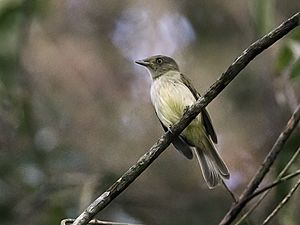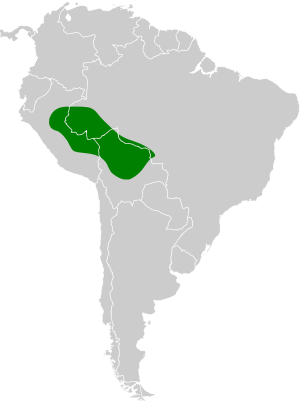Sulphur-bellied tyrant-manakin facts for kids
Quick facts for kids Sulphur-bellied tyrant-manakin |
|
|---|---|
 |
|
| Conservation status | |
| Scientific classification | |
| Genus: |
Neopelma
|
| Species: |
sulphureiventer
|
 |
|
The sulphur-bellied tyrant-manakin (Neopelma sulphureiventer) is a small, colorful bird. It is also known as the sulphur-bellied neopelma. This bird belongs to the Pipridae family, which includes many types of manakins.
You can find this special bird in the western part of the Amazon Basin. It lives in countries like Bolivia, Brazil, and Peru. Its favorite home is in warm, wet lowland forests.
Contents
What is a Sulphur-bellied Tyrant-Manakin?
The sulphur-bellied tyrant-manakin is a type of passerine bird. This means it is a perching bird, like many common birds you see. It is known for its bright yellow belly, which gives it its name. The word "sulphur" refers to the yellow color.
These birds are quite small. They are usually shy and hard to spot in the thick forest. They spend most of their time in the lower and middle parts of the trees.
Where Does This Bird Live?
The sulphur-bellied tyrant-manakin lives in a specific part of South America. Its home is the western Amazon rainforest. This huge forest is very important for many animals and plants.
Its Natural Habitat
This bird prefers a special kind of forest. It lives in subtropical or tropical moist lowland forest. This means the forest is warm all year round. It also gets a lot of rain, making it very humid.
The lowland part means it lives in areas that are not high up in mountains. These forests have many tall trees and thick plants. This provides good cover and plenty of food for the birds.
Countries Where It Lives
- Bolivia: You can find it in the northern parts of Bolivia.
- Brazil: It lives in the western Amazon region of Brazil.
- Peru: It is also found in the eastern parts of Peru.
These areas are all connected by the vast Amazon rainforest. This allows the birds to move around within their habitat.
What Does the Sulphur-bellied Tyrant-Manakin Look Like?
This bird is small, usually about 12 to 13 centimeters (around 5 inches) long. It has a distinctive look that helps identify it.
Colors and Markings
The most striking feature is its bright yellow belly. This is where it gets the "sulphur-bellied" part of its name. Its back and wings are usually a duller olive-green color. This helps it blend in with the leaves of the forest.
Some birds might have a slightly different shade of yellow or green. The male and female birds look very similar. This is not always the case with all bird species.
Beak and Legs
The bird has a small, pointed beak. This type of beak is good for catching insects and eating small fruits. Its legs are thin and strong, perfect for perching on branches.
What Does It Eat?
The sulphur-bellied tyrant-manakin is an omnivore. This means it eats both plants and animals. Its diet mainly consists of insects and small fruits.
Insects
Insects are a very important food source for this bird. It might catch flies, beetles, or other small bugs. Birds often find insects by looking under leaves or on tree bark.
Fruits
Small berries and fruits from the forest trees are also part of its diet. Eating fruits helps to spread seeds around the forest. This is important for the growth of new plants.
How Does It Behave?
These birds are generally quiet and not very active. They tend to stay hidden in the dense forest.
Foraging Habits
They often search for food alone or in pairs. They move slowly through the undergrowth and middle layers of the forest. They might hop from branch to branch, looking for food.
Calls and Songs
The sulphur-bellied tyrant-manakin has a simple call. It is not known for having a complex song like some other birds. Their calls are usually short and sharp.
Reproduction and Life Cycle
Like all birds, the sulphur-bellied tyrant-manakin reproduces by laying eggs. Not much is known about their specific breeding habits. This is because they are shy and live in dense forests, making them hard to study.
Nests and Eggs
Most manakins build cup-shaped nests. These nests are usually made from plant materials like twigs and leaves. They are often placed in low bushes or small trees. The female bird lays a few eggs, which are usually pale with dark spots.
Raising Young
The female bird usually takes care of incubating the eggs. After the chicks hatch, both parents might help feed them. The young birds grow quickly and soon learn to fly and find their own food.
Conservation Status
The sulphur-bellied tyrant-manakin is listed as "Least Concern" (LC) by the International Union for Conservation of Nature (IUCN). This means that its population is currently stable. It is not considered to be in danger of disappearing.
However, the Amazon rainforest is facing threats from deforestation. This is when forests are cut down for farming or other uses. Protecting the rainforest is important for all the animals that live there, including this unique bird.
See also
 In Spanish: Saltarín ventrisulfúreo para niños
In Spanish: Saltarín ventrisulfúreo para niños


